材料科学与工程专业英语1-18单元课后翻译答案
- 格式:doc
- 大小:59.50 KB
- 文档页数:7

材料科学与工程专业英语参考翻译(11-20)专业:材料物理姓名:43110103刘伟吉林大学材料科学科学与工程材料物理 154223585711微结构、加工过程和应用之间的联系微结构、加工过程和应用之间的联系材料科学与工程领域经常是根据四大方面—合成与加工,结构与组成,性质和性能之间的相互联系来定义的。
为了理解任意材料的行为(性能表现)与性质,有必要去了解它的结构。
结构可以从几个水平层次来考虑,这些都会影响材料的最终行为(性能表现)。
能够对材料的颜色、电导性和磁性产生影响的电子构型是材料的最精细的水平。
原子中的电子排布方式影响它是如何与其他原子结合的。
这(结合方式)反过来又对晶体结构有着重大影响;结晶陶瓷具有非常规则的原子排列,然而,这种长程有序的排列在非晶体和无定型陶瓷中却不存在,尽管在局部我们可以看到相似的多面体结构。
这种材料相对于它们的晶体经常表现出不同的行为。
我们不仅要考虑具有完美晶格和理想结构的情况,也要顾及到材料中不可避免的结构缺陷的存在,甚至是无定型的,这类缺陷例如杂质原子和位错。
多晶陶瓷的结构由许多晶粒组成。
晶粒的尺寸,形状和位向在这些材料的许多微观性质中扮演者重要的角色,例如力学强度。
在大多数陶瓷中,多相共存,每一相都有自己独特的结构、组成和性质。
对材料中的这些相的类型、尺寸、分布和总量的控制为控制性质提供了一种方式。
陶瓷的微观结构通常情况下是它所经历的加工过程的结果。
例如,热压处理的陶瓷一般情况下只有极少数孔隙,烧结材料很少有这种现象。
通过这篇课文,结构、加工过程和性质之间的相互联系将会很明显地显示出来。
但这里用5个例子来说明。
1. 根据霍尔派奇方程,多晶陶瓷的强度取决于晶粒尺寸。
一般来说,晶粒尺寸降低时,强度升高。
晶粒尺寸是由初始粉体颗粒的大小和它们的凝结方式所决定的。
多晶陶瓷中的境界也很重要。
强度自然取决于材料是否纯净、是否包含第二相或孔隙,抑或晶界处的玻璃态。
对于纳米陶瓷来说,这些关系却并非总是非常明显的。
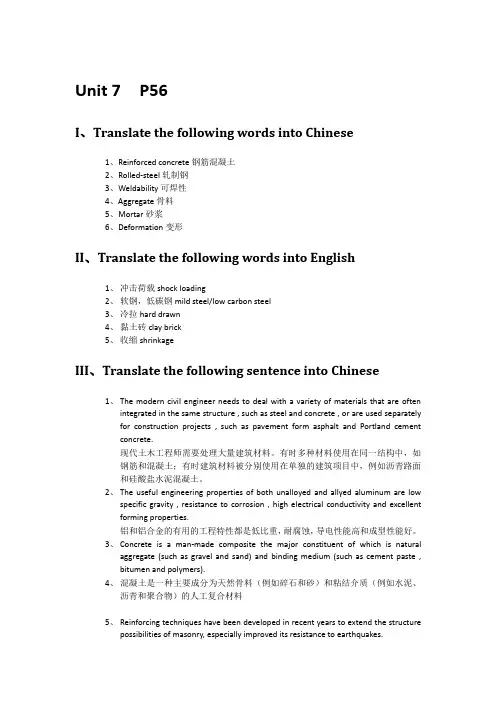
Unit 7 P56I、Translate the following words into Chinese1、Reinforced concrete钢筋混凝土2、Rolled-steel轧制钢3、Weldability可焊性4、Aggregate骨料5、Mortar砂浆6、Deformation变形II、Translate the following words into English1、冲击荷载shock loading2、软钢,低碳钢mild steel/low carbon steel3、冷拉hard drawn4、黏土砖clay brick5、收缩shrinkageIII、Translate the following sentence into Chinese1、The modern civil engineer needs to deal with a variety of materials that are oftenintegrated in the same structure , such as steel and concrete , or are used separatelyfor construction projects , such as pavement form asphalt and Portland cementconcrete.现代土木工程师需要处理大量建筑材料。
有时多种材料使用在同一结构中,如钢筋和混凝土;有时建筑材料被分别使用在单独的建筑项目中,例如沥青路面和硅酸盐水泥混凝土。
2、The useful engineering properties of both unalloyed and allyed aluminum are lowspecific gravity , resistance to corrosion , high electrical conductivity and excellentforming properties.铝和铝合金的有用的工程特性都是低比重,耐腐蚀,导电性能高和成型性能好。
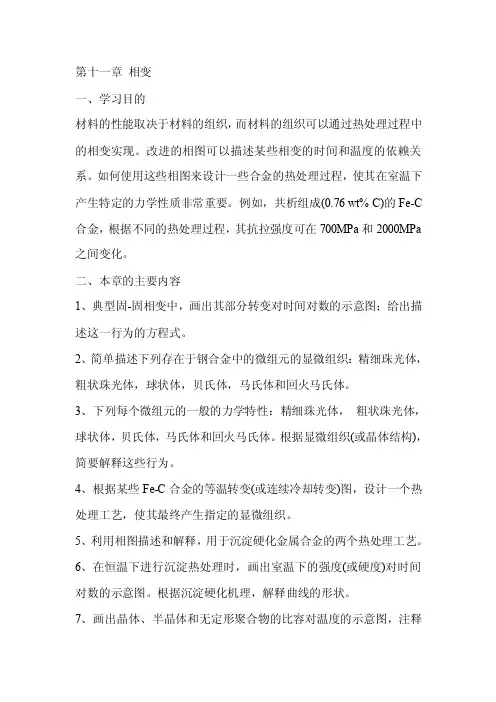
第十一章相变一、学习目的材料的性能取决于材料的组织,而材料的组织可以通过热处理过程中的相变实现。
改进的相图可以描述某些相变的时间和温度的依赖关系。
如何使用这些相图来设计一些合金的热处理过程,使其在室温下产生特定的力学性质非常重要。
例如,共析组成(0.76 wt% C)的Fe-C 合金,根据不同的热处理过程,其抗拉强度可在700MPa和2000MPa 之间变化。
二、本章的主要内容1、典型固-固相变中,画出其部分转变对时间对数的示意图;给出描述这一行为的方程式。
2、简单描述下列存在于钢合金中的微组元的显微组织:精细珠光体,粗状珠光体,球状体,贝氏体,马氏体和回火马氏体。
3、下列每个微组元的一般的力学特性:精细珠光体,粗状珠光体,球状体,贝氏体,马氏体和回火马氏体。
根据显微组织(或晶体结构),简要解释这些行为。
4、根据某些Fe-C合金的等温转变(或连续冷却转变)图,设计一个热处理工艺,使其最终产生指定的显微组织。
5、利用相图描述和解释,用于沉淀硬化金属合金的两个热处理工艺。
6、在恒温下进行沉淀热处理时,画出室温下的强度(或硬度)对时间对数的示意图。
根据沉淀硬化机理,解释曲线的形状。
7、画出晶体、半晶体和无定形聚合物的比容对温度的示意图,注释玻璃转变和熔化温度。
(相变=转化)11.1简介许多材料的力学和其它性质取决于其微观结构,而其往往是相变产生的。
在这一章的第一部分我们讨论相变的基本原则。
接下来,我们从事相变在铁-碳合金的微观结构的发展中扮演什么,以及其他合金,和微细结构的变化是如何影响力学性能。
最后,我们论述结晶、熔化、和聚合物的玻璃化转换。
金属相变---------------------------------------------------------------------------- 金属材料的多功能性的原因之一在于他们所拥有的力学性能的宽范围,是通过各种方法处理是可达到的。
在第8章中讨论的三个强化机理,叫做,晶粒细化、固溶强化和应变硬化。
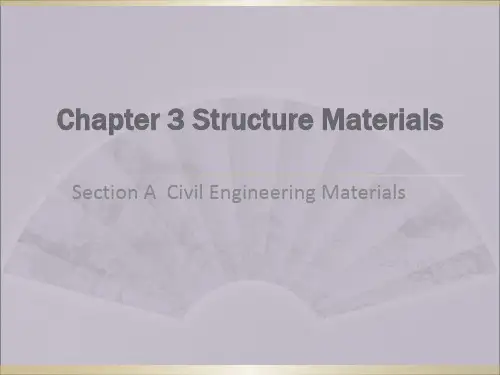
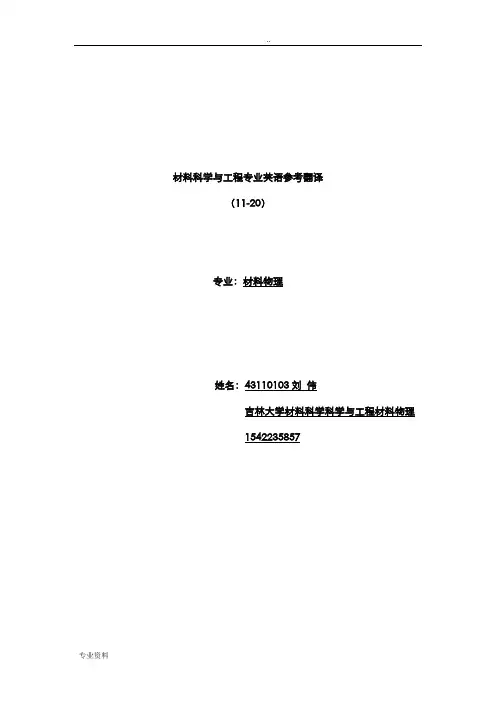
材料科学与工程专业英语参考翻译(11-20)专业:材料物理姓名:43110103刘伟吉林大学材料科学科学与工程材料物理154223585711微结构、加工过程和应用之间的联系微结构、加工过程和应用之间的联系材料科学与工程领域经常是根据四大方面—合成与加工,结构与组成,性质和性能之间的相互联系来定义的。
为了理解任意材料的行为(性能表现)与性质,有必要去了解它的结构。
结构可以从几个水平层次来考虑,这些都会影响材料的最终行为(性能表现)。
能够对材料的颜色、电导性和磁性产生影响的电子构型是材料的最精细的水平。
原子中的电子排布方式影响它是如何与其他原子结合的。
这(结合方式)反过来又对晶体结构有着重大影响;结晶陶瓷具有非常规则的原子排列,然而,这种长程有序的排列在非晶体和无定型陶瓷中却不存在,尽管在局部我们可以看到相似的多面体结构。
这种材料相对于它们的晶体经常表现出不同的行为。
我们不仅要考虑具有完美晶格和理想结构的情况,也要顾及到材料中不可避免的结构缺陷的存在,甚至是无定型的,这类缺陷例如杂质原子和位错。
多晶陶瓷的结构由许多晶粒组成。
晶粒的尺寸,形状和位向在这些材料的许多微观性质中扮演者重要的角色,例如力学强度。
在大多数陶瓷中,多相共存,每一相都有自己独特的结构、组成和性质。
对材料中的这些相的类型、尺寸、分布和总量的控制为控制性质提供了一种方式。
陶瓷的微观结构通常情况下是它所经历的加工过程的结果。
例如,热压处理的陶瓷一般情况下只有极少数孔隙,烧结材料很少有这种现象。
通过这篇课文,结构、加工过程和性质之间的相互联系将会很明显地显示出来。
但这里用5个例子来说明。
1. 根据霍尔派奇方程,多晶陶瓷的强度取决于晶粒尺寸。
一般来说,晶粒尺寸降低时,强度升高。
晶粒尺寸是由初始粉体颗粒的大小和它们的凝结方式所决定的。
多晶陶瓷中的境界也很重要。
强度自然取决于材料是否纯净、是否包含第二相或孔隙,抑或晶界处的玻璃态。
对于纳米陶瓷来说,这些关系却并非总是非常明显的。
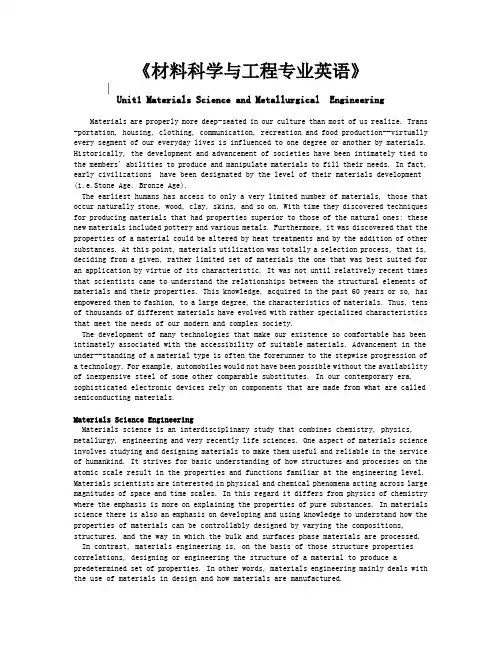
《材料科学与工程专业英语》Unit1 Materials Science and Metallurgical EngineeringMaterials are properly more deep-seated in our culture than most of us realize. Trans -portation, housing, clothing, communication, recreation and food production--virtually every segment of our everyday lives is influenced to one degree or another by materials. Historically, the development and advancement of societies have been intimately tied to the members' abilities to produce and manipulate materials to fill their needs. In fact, early civilizations have been designated by the level of their materials development (i.e.Stone Age, Bronze Age).The earliest humans has access to only a very limited number of materials, those that occur naturally stone, wood, clay, skins, and so on. With time they discovered techniques for producing materials that had properties superior to those of the natural ones: these new materials included pottery and various metals. Furthermore, it was discovered that the properties of a material could be altered by heat treatments and by the addition of other substances. At this point, materials utilization was totally a selection process, that is, deciding from a given, rather limited set of materials the one that was best suited for an application by virtue of its characteristic. It was not until relatively recent times that scientists came to understand the relationships between the structural elements of materials and their properties. This knowledge, acquired in the past 60 years or so, has empowered them to fashion, to a large degree, the characteristics of materials. Thus, tens of thousands of different materials have evolved with rather specialized characteristics that meet the needs of our modern and complex society.The development of many technologies that make our existence so comfortable has been intimately associated with the accessibility of suitable materials. Advancement in the under--standing of a material type is often the forerunner to the stepwise progression of a technology. For example, automobiles would not have been possible without the availability of inexpensive steel of some other comparable substitutes. In our contemporary era, sophisticated electronic devices rely on components that are made from what are called semiconducting materials.Materials Science EngineeringMaterials science is an interdisciplinary study that combines chemistry, physics, metallurgy, engineering and very recently life sciences. One aspect of materials science involves studying and designing materials to make them useful and reliable in the service of humankind. It strives for basic understanding of how structures and processes on the atomic scale result in the properties and functions familiar at the engineering level. Materials scientists are interested in physical and chemical phenomena acting across large magnitudes of space and time scales. In this regard it differs from physics of chemistry where the emphasis is more on explaining the properties of pure substances. In materials science there is also an emphasis on developing and using knowledge to understand how the properties of materials can be controllably designed by varying the compositions, structures, and the way in which the bulk and surfaces phase materials are processed.In contrast, materials engineering is, on the basis of those structure properties correlations, designing or engineering the structure of a material to produce a predetermined set of properties. In other words, materials engineering mainly deals with the use of materials in design and how materials are manufactured."Structure" is a nebulous term that deserves some explanation. In brief, the structure of a material usually relates to the arrangement of its internal components. Subatomic structure involves electrons within the individual atoms and interactions with their nuclei. On an atomic level, structure encompasses the organization of atoms or molecules relative to one another. The next large structural realm, which contains large groups of atoms that are normally agglomerated together, is termed "microscopic" meaning that which is subject to direct observation using some type of microscope. Finally, structural elements that may be viewed with the naked eye are termed "macroscopic".The notion of "property" deserves elaboration. While in service use, all materials are exposed to external stimuli that evoke some type of response. For example, a specimen subject to forces will experience deformation; or a polished metal surface will reflect light. Property is a material trait in terms of the kind and magnitude of response to a specific imposed stimulus. Generally, definitions of properties are made independent of material shape and size.Virtually all important properties of solid materials may be grouped into six different categories; mechanical, electrical, thermal, magnetic, optical, and deteriorative. For each there is s characteristic type of stimulus capable of provoking different responses. Mechanical properties relate deformation to an applied load or force: examples include elastic modulus and strength. For electrical properties, such as electrical conductivity and dielectric constant, the stimulus is an electric filed. The thermal behavior of solids can be represented in terms of heat capacity and thermal conductivity. Magnetic properties demonstrate the response of a material to the application of a magnetic field. For optical properties, the stimulus is electromagnetic or light radiation: index of refraction and reflectivity are representative optical properties. Finally, deteriorative characteristics indicate the chemical reactivity of materials.In addition to structure and properties, two other important components are involved in the science and engineering of materials, namely "processing" and "performance". With regard to the relationships of these four components, the structure of a material will depend on how it is processed. Furthermore, a material's performance will be a function of its properties. Thus, the interrelationship between processing, structure, properties, and performance is linear as follows:Processing→Structure→Properties→PerformanceWhy Study Materials Science and Engineering?Why do we study materials? Many an applied scientists or engineers, whether mechanical, civil, chemical, or electrical, will be exposed to a design problem involving materials at one time or another. Examples might include a transmission gear, the superstructure for a building, an oil refinery component, or an integrated circuit chip. Of course, materials scientists and engineers are specialists who are totally involved in the investigation and design of materials.Many times, a materials problem is to select the right material from many thousands available ones. There are several criteria on which the final decision is normally based. First of all, the in-service conditions must be characterized. On only rare occasion does a material possess the maximum or ideal combination of properties. Thus, it may be necessary to trade off one characteristic for another. The classic example involves strength and ductility; normally, a material having a high strength will have only a limited ductility. In such cases a reasonable compromise between two or more properties may be necessary.A second selection consideration is any deterioration of material properties that may occur during service operation. For example, significant reductions in mechanical strengthmay result from exposure to elevated temperatures or corrosive environments.Finally, probably the overriding consideration is economics. What will the finished product cost? A material may be found that has the ideal set of properties, but is prohibitively expensive. Here again, some compromise is inevitable. The cost of a finished piece also includes any expense incurred during fabrication.The more familiar an engineer or scientist is with the various characteristics and structure-property relationships, as well as processing techniques of materials, the more proficient and confident he or she will be to make judicious materials choices based on these criteria.(Selected from Materials Science and Engineering: AnIntroduction, by William D Callister,2002)New Words and Expressionspottery n. 陶瓷by virtue of 依靠(……力量),凭借,由于,因为empower vt.授权,准许,使能够empower sb.to do sth. 授权某人做某事forerunner n. 先驱(者),传令官,预兆stepwise a. 逐步地,分阶段地interdisciplinary a. 交叉学科的metallurgy n. 冶金学nebulous a. 星云的,云雾状的,模糊的,朦胧的agglomerate n. 大团,大块;a.成块的,凝聚的elaboration n. 详尽的细节,解释,阐述electrical conductivity 电导性,电导率dielectric constant 介电常数thermal conductivity 热导性,热导率heat capacity 热容refraction n. 衍射reflectivity n. 反射ductility n. 延展性corrosive a. 腐蚀的,蚀坏的,腐蚀性的;n. 腐蚀物,腐蚀剂overriding a. 最重要的;高于一切的prohibitive a. 禁止的,抵制的judicious a. 明智的criterion n. 标准,准则,尺度Notes1. It was not until relatively recent times that scientists came to understand the relationships between the structural elements of materials and their properties.这是一个强调句,强调时间。
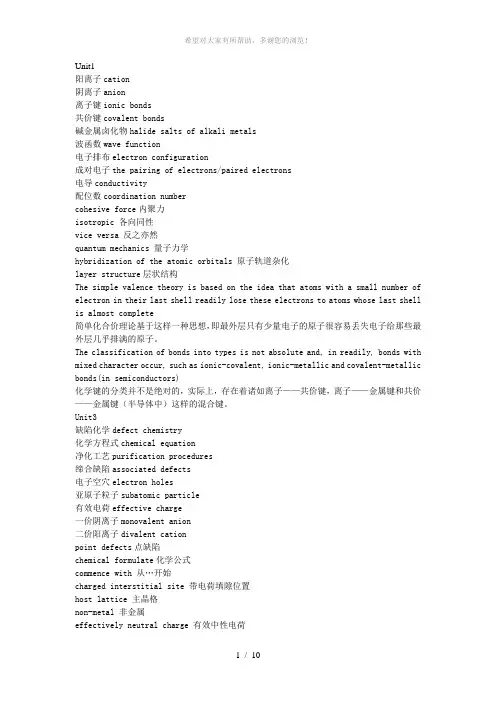
Unit1阳离子cation阴离子anion离子键ionic bonds共价键covalent bonds碱金属卤化物halide salts of alkali metals波函数wave function电子排布electron configuration成对电子the pairing of electrons/paired electrons电导conductivity配位数coordination numbercohesive force内聚力isotropic 各向同性vice versa 反之亦然quantum mechanics 量子力学hybridization of the atomic orbitals 原子轨道杂化layer structure层状结构The simple valence theory is based on the idea that atoms with a small number of electron in their last shell readily lose these electrons to atoms whose last shell is almost complete简单化合价理论基于这样一种思想,即最外层只有少量电子的原子很容易丢失电子给那些最外层几乎排满的原子。
The classification of bonds into types is not absolute and, in readily, bonds with mixed character occur, such as ionic-covalent, ionic-metallic and covalent-metallic bonds(in semiconductors)化学键的分类并不是绝对的,实际上,存在着诸如离子——共价键,离子——金属键和共价——金属键(半导体中)这样的混合键。
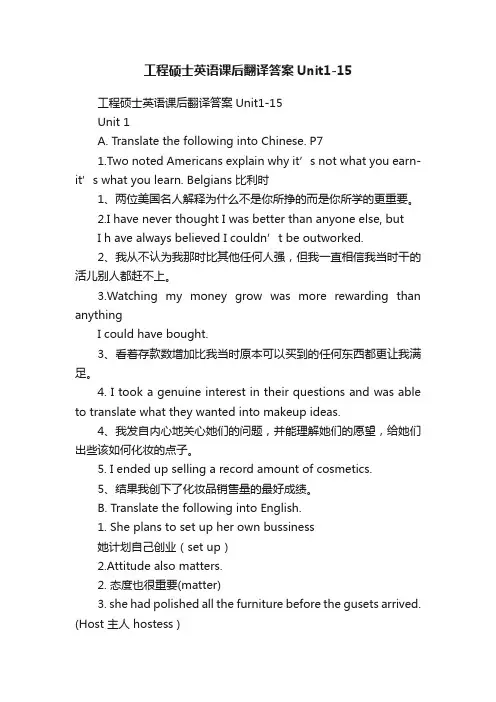
工程硕士英语课后翻译答案Unit1-15工程硕士英语课后翻译答案Unit1-15Unit 1A. Translate the following into Chinese. P71.Two noted Americans explain why it’s not what you earn-it’s what you learn. Belgians 比利时1、两位美国名人解释为什么不是你所挣的而是你所学的更重要。
2.I have never thought I was better than anyone else, butI h ave always believed I couldn’t be outworked.2、我从不认为我那时比其他任何人强,但我一直相信我当时干的活儿别人都赶不上。
3.Watching my money grow was more rewarding than anythingI could have bought.3、看着存款数增加比我当时原本可以买到的任何东西都更让我满足。
4. I took a genuine interest in their questions and was able to translate what they wanted into makeup ideas.4、我发自内心地关心她们的问题,并能理解她们的愿望,给她们出些该如何化妆的点子。
5. I ended up selling a record amount of cosmetics.5、结果我创下了化妆品销售量的最好成绩。
B. Translate the following into English.1. She plans to set up her own bussiness她计划自己创业(set up)2.Attitude also matters.2. 态度也很重要(matter)3. she had polished all the furniture before the gusets arrived. (Host 主人 hostess )3.她在客人们到达之前把所有家具都擦亮了. (polish)4.Some managers have no idea how to handle people. Conminute沟通4.有些经理不知道如何与人打交道。
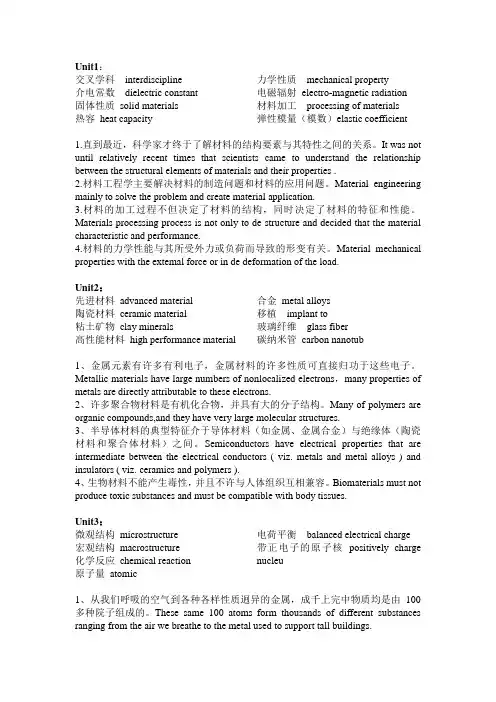
Unit1: 交叉学科 interdiscipline 介电常数 dielectric constant 固体性质 solid materials 热容 heat capacity 力学性质 mechanical property 电磁辐射 electro-magnetic radiation 材料加工 processing of materials 弹性模量(模数)elastic coefficient
1.直到最近,科学家才终于了解材料的结构要素与其特性之间的关系。It was not until relatively recent times that scientists came to understand the relationship between the structural elements of materials and their properties . 2.材料工程学主要解决材料的制造问题和材料的应用问题。Material engineering mainly to solve the problem and create material application. 3.材料的加工过程不但决定了材料的结构,同时决定了材料的特征和性能。Materials processing process is not only to de structure and decided that the material characteristic and performance. 4.材料的力学性能与其所受外力或负荷而导致的形变有关。Material mechanical properties with the extemal force or in de deformation of the load.
Unit2: 先进材料 advanced material 陶瓷材料 ceramic material 粘土矿物 clay minerals 高性能材料 high performance material 合金 metal alloys 移植 implant to 玻璃纤维 glass fiber 碳纳米管 carbon nanotub
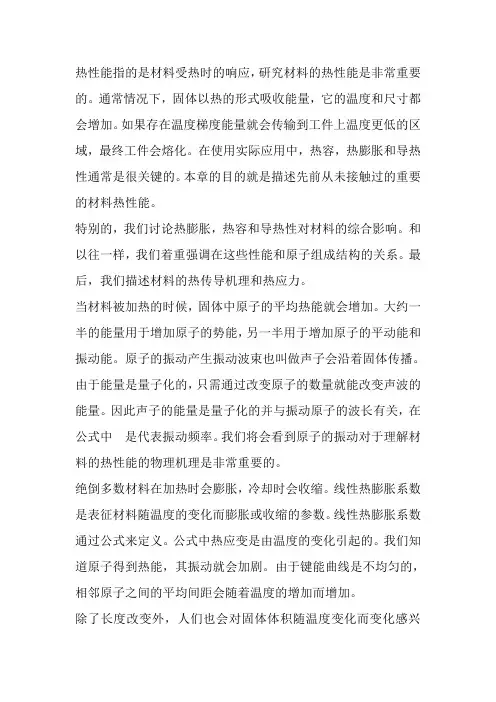
热性能指的是材料受热时的响应,研究材料的热性能是非常重要的。
通常情况下,固体以热的形式吸收能量,它的温度和尺寸都会增加。
如果存在温度梯度能量就会传输到工件上温度更低的区域,最终工件会熔化。
在使用实际应用中,热容,热膨胀和导热性通常是很关键的。
本章的目的就是描述先前从未接触过的重要的材料热性能。
特别的,我们讨论热膨胀,热容和导热性对材料的综合影响。
和以往一样,我们着重强调在这些性能和原子组成结构的关系。
最后,我们描述材料的热传导机理和热应力。
当材料被加热的时候,固体中原子的平均热能就会增加。
大约一半的能量用于增加原子的势能,另一半用于增加原子的平动能和振动能。
原子的振动产生振动波束也叫做声子会沿着固体传播。
由于能量是量子化的,只需通过改变原子的数量就能改变声波的能量。
因此声子的能量是量子化的并与振动原子的波长有关,在公式中是代表振动频率。
我们将会看到原子的振动对于理解材料的热性能的物理机理是非常重要的。
绝倒多数材料在加热时会膨胀,冷却时会收缩。
线性热膨胀系数是表征材料随温度的变化而膨胀或收缩的参数。
线性热膨胀系数通过公式来定义。
公式中热应变是由温度的变化引起的。
我们知道原子得到热能,其振动就会加剧。
由于键能曲线是不均匀的,相邻原子之间的平均间距会随着温度的增加而增加。
除了长度改变外,人们也会对固体体积随温度变化而变化感兴趣。
通过义体积热膨胀系数,我们能得到下面这个方程。
其中是初始体积,是由温度变化所引起的材料体积的变化。
对于各向同性的固体而言,体积热膨胀系数和线性热膨胀系数的关系是。
然而我们也应该意识到并不是所有材料都是各向同性的。
讨论到现在我们也许会得到错误的结论的图像是温度的函数,这个图像是通过给予的斜度产生的一条直。
图9.1中展示了来自这种行为的某些误差展示了一些的突然变化,这一温度变化与二氧化硅的晶体结构有关。
该临界温度是材料发生多晶体相变时的温度。
然而,即使对于单晶材料,也能经常观察到来自应变随温度变化而变化行为的误差。
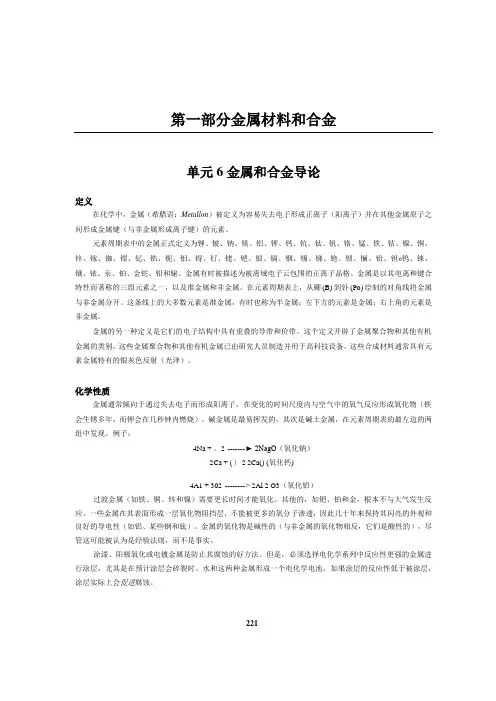
第一部分金属材料和合金单元 6 金属和合金导论定义在化学中,金属(希腊语:Metallon)被定义为容易失去电子形成正离子(阳离子)并在其他金属原子之间形成金属键(与非金属形成离子键)的元素。
元素周期表中的金属正式定义为锂、铍、钠、镁、铝、钾、钙、钪、钛、钒、铬、锰、铁、钴、镍、铜、锌、镓、铷、锶、钇、锆、铌、钼、锝、钌、铑、钯、银、镉、铟、锡、锑、铯、钡、镧、铪、钽»钨、铼、锇、铱、汞、铂、金铊、铅和铋。
金属有时被描述为被离域电子云包围的正离子晶格。
金属是以其电离和键合特性而著称的三组元素之一,以及准金属和非金属。
在元素周期表上,从硼 (B) 到钋 (Po) 绘制的对角线将金属与非金属分开。
这条线上的大多数元素是准金属,有时也称为半金属;左下方的元素是金属;右上角的元素是非金属。
金属的另一种定义是它们的电子结构中具有重叠的导带和价带。
这个定义开辟了金属聚合物和其他有机金属的类别,这些金属聚合物和其他有机金属已由研究人员制造并用于高科技设备。
这些合成材料通常具有元素金属特有的银灰色反射(光泽)。
化学性质金属通常倾向于通过失去电子而形成阳离子,在变化的时间尺度内与空气中的氧气反应形成氧化物(铁会生锈多年,而钾会在几秒钟内燃烧)。
碱金属是最易挥发的,其次是碱土金属,在元素周期表的最左边的两组中发现。
例子:4Na + 。
2 ------- ► 2NagO(氧化钠)2Ca + ( ) 2 2Ca() (氧化钙)4A1 + 302 -------- > 2Al 2 O3(氧化铝)过渡金属(如铁、铜、锌和镍)需要更长时间才能氧化。
其他的,如钯、铂和金,根本不与大气发生反应。
一些金属在其表面形成一层氧化物阻挡层,不能被更多的氧分子渗透,因此几十年来保持其闪亮的外观和良好的导电性(如铝、某些钢和钛)。
金属的氧化物是碱性的(与非金属的氧化物相反,它们是酸性的),尽管这可能被认为是经验法则,而不是事实。
Unit 1Materials science材料科学Stone age石器时代Naked eye肉眼Bronze age铜器时代Optical property光学性能Integrated circuit集成电路Mechanical strength机械强度Thermal conductivity导热“Materials science” involves investigating the relationships that exist between the structures and properties of materials. In contrast ,”materials engineering “is ,on the basis of there structure property correlations ,designing or engineering the structure of a material that produce a predetermined set of properties。
,材料工程是根据材料的结构和性质的关系来设计或操纵材料的结构以求制造出一系列可预定的性质。
从功能方面来说,材料科学家的作用是发展或合成新的材料Virtually all important properties of solid materials may be grouped into six different categories: mechanical, electrical, thermal, magnetic, optical ,and deteriorative。
固体材料的所有重要的性质可以分成六个不同的种类,机械性能、电性能、热性能、磁性能、光性能和耗。
In addition to structure and properties , two other important components are involved in the sciences and engineering of materials , namely“processing”and“performance”.除了组织性能之外,另外两个重要的性质也包括在材料科学和工程之中,即“加工”和“特性”The more familiar an engineer or scientist is with the various characteristics and structure-property relationship,as well as processing techniques of material,the more proficient and confident he or she will be to make judicious materials choices based on these criteria。
Unit 1 Translation. 1.“材料科学”涉及到研究材料的结构与性能的关系。相反,材料工程是根据材料的结构与性质的关系来涉及或操控材料的结构以求制造出一系列可预定的性质。 2.实际上,所有固体材料的重要性质可以分为六类:机械、电学、热学、磁学、光学、腐蚀性。 3.除了结构与性质,材料科学与工程还有其他两个重要的组成部分,即加工与性能。 4.工程师或科学家越熟悉材料的各种性质、结构、性能之间的关系以及材料的加工技术,根据以上的原则,他或她就会越自信与熟练地对材料进行更明智的选择。 5.只有在少数情况下,材料才具有最优或最理想的综合性质。因此,有时候有必要为某一性质而牺牲另一性能。 6.Interdisciplinary dielectric constant Solid material(s) heat capacity Mechanical property electromagnetic radiation Material processing elastic modulus 7.It was not until relatively recent times that scientists came to understand the relationships between the structural elements of materials and their properties. 8. Materials engineering is to solve the problem during the manufacturing and application of materials. 9. 10.Mechanical properties relate deformation to an applied load or force. Unit 2 1. 金属是电和热很好的导体,在可见光下不透明;擦亮的金属表面有金属光泽。 2. 陶瓷是典型的导热导电的绝缘体,并且比金属和聚合物具有更高的耐热温度和耐恶劣环境性能。 3. 用于高科技领域的材料有时也被称为先进材料。 4. 压电陶瓷在电场作用下膨胀和收缩;反之,当它们膨胀和收缩时,他们也能产生一个电场。 5. 随着能够观察单个原子或者分子的扫描探针显微镜的出现,操控和移动原子和分子以形成新结构成为可能,因此,我们能通过一些简单的原子水平的构建就可以设计出新的材料。 6. advanced materials ceramic materials high-performance materials clay minerals alloy implant glass fibre carbon nanotube 7. Metallic materials have large numbers of nonlocalized electrons and many properties of metals are directly attributable to these electrons. 8. Many of polymeric materials are organic compounds with very large molecular structures. 9. Semiconductors hace electrical properties that are intermediate between the electrical conductors(viz. metals and metal alloys) and insulators(viz. ceramics and polymers). 10. Biomaterials must not produce toxic substances and must be compatible with body tissues.
Unit 3 1. 金属的行为(性质)不同于陶瓷的行为(性质),陶瓷的行为(性质)不同于聚合物的行为(性质)。 2. 原子结构主要影响化学性质、物理性质、热学性质、电学性能、磁性能、光学性能。微结构和宏观结构虽也能影响这些性能但是他们主要影响力学性能和化学反应速率。 3. 金属的强度表明原子是通过强的键结合在一起的。 4. 元素的原子序数表明该元素的原子核内带正电的质子数。而原子的原子量则表明该原子核中质子数与中子数。 5. Microstructure macrostructure Chemical reaction atomic weight Balanced electrical charge positively charged proton 6. 100 atoms form thousands of different substances ranging from the air we breathe to the metal used to support tall buildings, 7.The facts suggests that metallic atoms are held together bu strong bonds. 8. Microstructure which includes features that cannot be seen with the naked eye,but using a microscope. Macrostructure includes features that can be seen with the naked eye. 9. The atomic weight is the sum of proton number and neutron number in the nucleus. Unit 4 1. 当密度小于水的密度时,物体将漂浮在水面上,当密度大于水的密度时,物体会沉降。相似的,当比重小于1时,物体将漂浮在水面上,当比重大于1时,物体会沉降。 2. 由于相互排斥而往相反的方向移动,导致磁通量密度比真空中小,这种材料为反磁性材料。 3. 使磁通量密度提高1倍以上小于或等于10倍的材料叫顺磁性材料,使磁通量密度提高10倍以上的材料叫铁磁性材料。 4. 某些铁磁性材料,特别是一些粉末状或夹层铁,钢或镍合金的相对导磁率可高达1000000。反磁性材料的相对导磁率小于1,但是到目前还没有哪种材料的相对导磁率远小于1。 5. 当顺磁性或铁磁性的芯插入线圈时,其磁感应系数等于相对磁导率乘以空芯时的磁感应系数。 6. specific gravity boiling point magnetic induction coefficient of thermal conductivity glass transition temperature non-ferrous metals linear coefficient of thermal expansion mass per unit of volume 7. Properties that describe how a substance changes into a completely different substance are called chemical properties. 8. Phase is a physical property of matter and matter can exist in four phases: solid, liquid, gas and plasma. 9. At some temperature below the melting point, polymers start to lose their crystalline structure but the molecules remain linked in chains, which tesults in a soft and pliable material. 10. In engineering applications, permeability is often expressed in relative, rather than in absolute. Unit 5 1. 金属的力学性能决定了材料的使用范围及期望的服役寿命。 2. 因此,一般多测几次以得到力学性能,报导的数值一般是平均值或者计算的统计最小值。 3.材料的承载方式极大地影响了材料的力学性能,也决定了材料失效形式,以及在失效前是否有预警。 4.然而,受力弯曲时会产生一个应力分布,应力大小与到轴线的垂直距离有关。 5.材料受到低于临界压力即屈服强度的力时,材料才会发生弹性形变。 6. Test specimen static loading force normal axis Engineering strain critical stress yield strength stress area Stress- strain curve 7. Temperatures below room temperature generally cause an increase in strength properties of metallic alloys; while ductility, fracture toughness, and elongation usually decrease. 8. From the respective of what is happening within a material, stress is the internal distribution of forces within a body that balance and react to the loads applied to it. 9. Engineering strain is defined as the amount of deformation in the direction of the applied force divided by the initial length of the material. 10. A material with high strength and high ductility will hace more toughness than a material with low strength and high ductility.